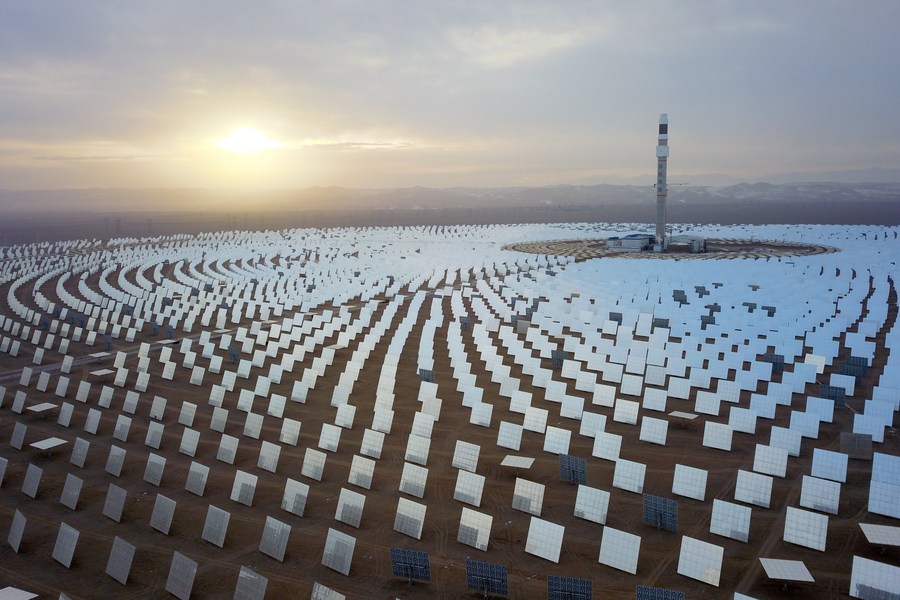LANZHOU, March 3 (Xinhua) -- The sky clears as the sun rises over the vast Gobi Desert. Like sunflowers, 12,000 mirrors, each covering 115 square meters, are arranged in concentric circles, concentrating tens of thousands of beams of sunlight onto the central heat absorption tower.
This is China's largest molten salt solar thermal power station, located in Dunhuang City, northwest China's Gansu Province, an area with rich solar energy resources.
At the top of the 260-meter-high tower, the heat absorber accumulates energy to heat up molten salt flowing inside. The molten salt then generates high-temperature and high-pressure steam, which drives a steam turbine generator to generate electricity.

Aerial photo taken on Feb. 24, 2021 shows a molten-salt solar thermal power plant in Dunhuang, northwest China's Gansu Province. (Xinhua/Ma Xiping)
Built by Shouhang Resources Saving Dunhuang CSP Power Generating Co., Ltd., the power station entered operation in December 2018 with a designed annual power generation of 390 million kWh.
When operating at full capacity, it can generate 100,000 kWh of electricity per hour, enabling a million 100-watt light bulbs to work for an hour, said Liu Fuguo, general manager of the station.
As Gansu is a major provider of power in the "west-to-east power transmission" project, the Dunhuang power station has been transmitting electricity through a widespread transmission network, lighting up thousands of buildings in eastern China.
According to Liu, without the need to burn fuel or produce pollution, solar thermal power generation is a new energy technology with the potential to become a base load power source.
Compared with traditional photovoltaic power generation, solar thermal power stations can store heat so as to guarantee continuous and stable output, complementing ordinary solar power that remains weather-dependent.
"If we compare the mirror field to a solar collector, the molten salt pot can be seen as an accumulator, which allows energy to be stored and later used to generate power on demand," said Liu.
"Even at night or in the rain, it can continue to generate electricity, maximizing the utilization rate of solar energy," he added.

Aerial photo taken on Dec. 26, 2018 shows a part of a molten-salt solar thermal power plant in Dunhuang, northwest China's Gansu Province. (Xinhua/Fan Peishen)
China has continuously promoted the development of clean energy in recent years. According to a white paper on the country's energy development released in December 2020, clean energy consumption accounted for 23.4 percent of China's total energy consumption in 2019, an increase of 8.9 percentage points over 2012.
The country has also vowed to peak carbon dioxide emissions by 2030 and achieve carbon neutrality by 2060.
Industry insiders believe that solar thermal power generation is expected to play an important role in the future, helping China achieve these goals. Statistics have shown that the station is able to reduce annual carbon dioxide emissions by 350,000 tonnes, equivalent to afforesting some 666.67 hectares of land.
According to Huang Wenbo, vice chairman of Shouhang Hi-Tech Energy Technology Co., Ltd., the parent company of the Dunhuang firm, solar thermal power generation is still in the developmental stage worldwide.
The smooth operation of the Dunhuang power station provides a model for promoting solar thermal power technology in China and has accumulated technical experience for the country to move further into the global new energy market, he added. ■




